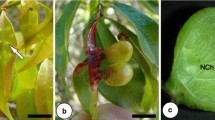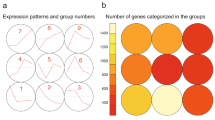Summary
The plant ectoparasitic nematodeLongidorus elongatus induces distinct changes in the root-tip nuclei of perennial ryegrass (Lolium perenne L.). There was an initial shift in DNA content into the 4C category, followed by further increases with values intermediate between 8C and 16C present after eight days. Nuclear size was reduced after six days due to increased nuclear division during hyperplasia. Nuclear DNA content and size decreased in galls older than eight days as a result of nuclear disintegration induced byL. elongatus. In cells near to the feeding site, nuclei became split into several, small globules. In more distant nuclei DNA-containing material became dispersed throughout the cytoplasm. In the oldest galls, cells were largely devoid of nuclei.
Similar content being viewed by others
References
Feder, N. &O'Brien, T. P. (1968) Plant microtechnique: some principles and new methods.Am. J. Bot. 55, 123–42.
Griffiths, B. S., Robertson, W. M. &Trudgill, D. L. (1982). Nuclear changes induced by the nematodesXiphinema diversicaudatum andLongidorus elongatus in root-tips of perennial ryegrass,Lolium perenne.Histochem. J. 14, 719–30.
Kasten, F. H. &Lala, R. (1975) The Feulgen reaction after glutaraldehyde fixation.Stain Technol. 50, 197–201.
Kurppa, S. &Robertson, W. M. (1979) Cell response to feeding byX. diversicaudatum andL. elongatus.Rep. Scott. hort. Res. Inst. 25, 119–20.
Robertson, W. M. &Trudgill, D. L. (1978) Feeding ofLongidorus andXiphinema spp. in relation to plant response and virus transmission.Rep. Scott. hort. Res. Inst. 24, 110–11.
Thorne, G. &Swanger, H. H. (1936) A monograph of the nematode generaDorylaimus dujardin,Aporcelaimus N.G.,Dorylaimoides N.G. andPungentus N.G.Capita Zool. 6, 1–223.
Towle, A. &Doncaster, C. C. (1978) Feeding ofLongidorus caespiticola on ryegrass,Lolium perenne.Nematologica 24, 277–85.
Trudgill, D. L. &Robertson, W. M. (1979) Feeding behaviour ofLongidorus elongatus andXiphinema diversicaudatum.Rep. Scott. hort. Res. Inst. 25, 118–19.
Wyss, U. (1981) Ectoparasitic root nematodes: feeding behaviour and plant cell responses. InPlant Parasitic Nematodes. Vol. 3. (edited byZuckerman, B. M. andRhode, R. A.), pp. 325–54. New York, San Francisco, London: Academic Press.
Wyss, U., Lehmann, H. &Jank-Ludwig, R. (1980) Ultrastructure of modified root-tip cells inFicus carica, induced by the ectoparasitic nematodeXiphinema index, J. Cell. Sci. 41, 193–208.
Author information
Authors and Affiliations
Rights and permissions
About this article
Cite this article
Griffiths, B.S., Robertson, W.M. Nuclear changes induced by the nematodeLongidorus elongatus in root-tips of ryegrass,Lolium perenne . Histochem J 15, 927–934 (1983). https://doi.org/10.1007/BF01011831
Received:
Revised:
Issue Date:
DOI: https://doi.org/10.1007/BF01011831




